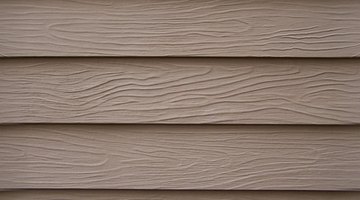How to Repair Masonite Hardboard Siding
Masonite is a brand name for one of the oldest brands of hardboard. Hardboard is a composite wood product made from very fine wood pulp and water. The pulp is mashed and pressed into shape as a paste, much like papier-mache. The extra water is pressed out through the use of screens.

Things You Will Need
- Body filler putty
- Putty knife
- Chisel
- Sander
- Paint and brush
- Pry bar
- Hammer or drill
- Nails or screws
- Replacement siding
Hardboard siding is molded into a shape similar to that of wooden clapboard siding planks, including a simulated wood grain. Hardboard siding is rugged but may be damaged by impact or improper fastener application in the form of a split or chip.
Repairing Damaged Siding
-
Remove any loose fragments of siding in the damaged area. If the siding is damp, allow it to dry completely before continuing with the repair.
-
Mix a small amount of epoxy auto body filler with a flexible metal putty knife. Make your mixture a little “hot” with one part hardener to seven parts putty. It will dry faster, but set harder, which results in a more permanent repair.
-
Fill the damaged area with the epoxy putty using the putty knife. Level the putty off with the face of the surrounding siding. Allow it to sit until the putty hardens, typically 15 to 20 minutes.
-
Work the putty with a knife, chisel or other tool to shape its surface to match the grain of the surrounding siding. Sand off any excess.
-
Prime the repaired area with an oil bonding primer and a paintbrush. Allow the primer to dry for an hour before painting the repaired area to match the surrounding siding.
Replacing Badly Damaged Planks
-
Remove the cap trim at the top of the wall where the damaged planks are installed. Use a drill for screwed down siding or a pry bar for nailed installation. Remove the screws or nails from the top and as many other planks as necessary to reach the damaged section.
-
Pry the damaged boards off the wall. Use them as a template to mark new boards to length, copying any needed profiles to fit around doors, windows, etc. Cut the replacement plank with a jigsaw and check for proper fit. Fasten the new plank in place with nails or screws.
-
Replace the planks above the damaged area. Ensure each board is firmly attached. Realign the cap trim, and fasten it in place.
Check out this related video from Homesteady on Youtube.
References
- “The Complete Guide to Roofing & Siding”; Creative Publishing International, 2004
- “Ortho's All About Roofing and Siding Basics”; Ortho Books, 2001
Writer Bio
Mark Morris started writing professionally in 1995. He has published a novel and stage plays with SEEDS studio. Morris specializes in many topics and has 15 years of professional carpentry experience. He is a voice, acting and film teacher. He also teaches stage craft and lectures on playwriting for Oklahoma Christian University.
Photo Credits
- house siding 3 image by Psycience from Fotolia.com
- house siding 3 image by Psycience from Fotolia.com
More Articles



